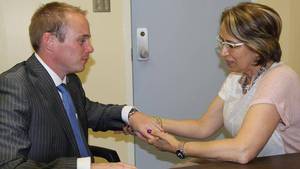GE Healthcare Canada is working with the QEII's BIOTIC, a core research facility, to improve patient care through new medical imaging technology.
The goal of this collaboration is to develop and validate software-powered medical imaging technology as added solutions and features to GE Healthcare's MRI systems. Each product is being developed as “pushbutton” —improving efficiency, consistency and accuracy of the MRI results - improving care for patients in Nova Scotia and around the world. Dr. Steven Beyea, the scientific lead for BIOTIC, says as they develop the new technologies for GE, QEII patients will be the first in the world to get access to it.
The three projects announced in the fall will help in several areas: pre-surgical functional mapping will help surgeons better understand where brain functions reside to guide their decisions during surgery. The imaging software technology will also improve diagnosis of fatty liver disease, which is especially common in Atlantic Canada and improve the diagnosis of prostate cancer.
“Within five years, we hope to have all three research projects developed and ready to be commercialized for GE to sell to the world. All three of these products represent a dramatic improvement in both patient care and diagnostic efficiency,” Dr. Beyea says.
GE will sell the technologies as part of their MRI product and then pay licence revenue to the QEII.
“We have a tendency in Nova Scotia to think that surely we can’t compete with the Harvards and Stanfords of the world because we are too small. But research innovation is not about being the biggest, it is about being nimble and creative enough to make it across the finish line first,” Dr. Beyea says.
Dr. Pat McGrath, vice-president of research and innovation for the Nova Scotia Health Authority, says he works with researchers around the world and what we have with BIOTIC is unique. “What makes BIOTIC special is they are a research group embedded in both the region's largest health centres: the QEII Health Sciences Centre and the IWK Health Centre, with a mandate to translate medical innovation through commercial partnerships, thereby improving patient care,” he says.
Their team of researchers, technicians, engineers and business people weave their work into the clinical world of physician and surgeons, he added. BIOTIC is a partnership between the QEII and the IWK. It works to turn medical science innovations into commercial successes.
Dr. McGrath says they hope the projects will result in innovations that will start in Halifax and spread around the globe.
“This is an important collaboration for Nova Scotia's life sciences sector. We are partnering and working with industry to develop new technologies, which will result in economic benefit to our province and improve care for patients,” says Dr. McGrath. “GE Healthcare is at the pinnacle of the medical research game. They could work with anyone in the world, but they chose BIOTIC. This collaboration represents a significant opportunity for us.”








